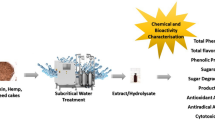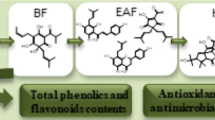Abstract
The recovery of effluents for different uses is an interesting practice that can contribute to a better management of water resources all over the world. Tiger nuts or “chufa” (Cyperus esculentus) are tubers mainly used to produce “horchata de chufa” (tiger nuts milk), yielding a high quantity of co-products (solids and liquids). The composition of these co-products makes them suitable for other uses. The aim of this work was to study the composition, microbial quality, physicochemical properties, and antioxidant activity of the “horchata” drained-water. The obtained results prove that “horchata” drained-water could be considered a valuable source of natural antioxidants. A good correlation between total phenol content and reducing power, rancimat performance, and inhibition of lipid peroxidation of buffered egg yolk assays supports the idea that phenols may be the main contributors to the antioxidant power of “horchata” drained-water. However, its microbial quality is poor, so this liquid residue must be heat-treated before its addition to any food product.



Similar content being viewed by others
References
Abdel-Akher, M., & Michalinos, A. N. (1963). Separation and purification of starch from chufa nut tubers (Cyperus esculentus). Stärke/Starch, 9, 329–334.
Amaral, C., Lucas, M. S., Coutinho, J., Crespí, A. L., Anjos, M. R., & Pais, C. (2008). Microbiological and physicochemical characterization of olive mill wastewaters from a continuous olive mill in Northeastern Portugal. Bioresource Technology, 99, 7215–7223.
Amensour, M., Sendra, E., Jamal, A., Bouhdid, S., Pérez-Alvarez, J. A., & Fernández-López, J. (2009). Total phenolic content and antioxidant activity of myrtle (Myrtus communis) extracts. Natural Products Communications, 4(6), 819–824.
AOAC. (1997). Official methods of analysis of AOAC International (16th ed.). Washington, DC: Association of Official Analytical Chemists.
Campos de Faria, D., Ulson de Souza, A. A., & de Arruda-Guelli, M. (2009). Optimization of water networks in industrial processes. Journal of Cleaner Production, 17, 857–862.
Capra, A., & Scicolone, B. (2007). Recycling of poor quality urban wastewater by drip irrigation systems. Journal of Cleaner Production, 15, 1529–1534.
Cortés, C., Esteve, M. J., Frígola, A., & Torregrosa, F. (2004). Physical and chemical properties of different commercially available types of “horchata de chufa”. Italian Journal of Food Science, 16(1), 113–121.
Coskuner, Y., Ercan, R., Karababa, E., & Nazlican, A. N. (2002). Physical and chemicals properties of chufa (Cyperus esculentus L) tubers brown in the Çukurova region of Turkey. Journal of the Science of Food and Agriculture, 82, 625–631.
CRDO (2009). Consejo Regulador de la Denominación de Origen Chufa de Valencia, Spain, Available at: www.chufadevalencia.org. Accessed 18 November 2009.
Daker, M., Abdullah, N., Vikineswary, S., Goh, P. C., & Kuppusamy, U. R. (2008). Antioxidant from maize and maize fermented by Marasmiellus sp. as stabiliser of lipid-rich foods. Food Chemistry, 107, 1092–1098.
Doughty, E. (1995). Separation of acids, carbohydrates and fermentation products by HPLC. Lebensmittel- und Biotechnologie, 12, 100–101.
Federici, F., Fava, F., Kalogerakis, N., & Mantzavinos, D. (2009). Valorisation of agro-industrial by-products, effluents and waste: concept, opportunities and the case of olive mill wastewaters. Journal of Chemical Technology and Biotechnology, 84, 895–900.
Fernández-López, J., Zhi, N., Aleson-Carbonell, L., Pérez-Alvarez, J. A., & Kuri, V. (2005). Antioxidant and antibacterial activities of natural extracts: application in beef meatballs. Meat Science, 69, 371–380.
Forster, A., Simon, K., Schmidt, R. & Kaltner, D. (2001). In: Proceedings of the EBC-Congress. What is it about antioxidative characteristic of hops? Budapest, Hungary.
Frankel, E. N. (1993). In search of better methods to evaluate natural antioxidants and oxidative stability in food lipids. Trends in Food Science and Technology, 4(7), 220–225.
Gómez-López, M. D., Bayo, J., García-Cascales, M. S., & Angosto, J. M. (2009). Decision support in disinfection technologies for treated wastewater reuse. Journal of Cleaner Production, 17, 1504–1511.
Grcić, I., Vujević, D., Sepcić, J., & Koprivanac, N. (2009). Minimization of organic content in simulated industrial wastewater by Fenton type processes: a case study. Journal of Hazardous Materials, 170, 954–961.
ISO 758. (1976). Liquid chemical products for industrial use—determination of density at 20 °C. Genève: International Organization for Standardization.
Karacabey, E., Mazza, G., Bayindirli, L. and Artik, N. (2010). Extraction of bioactive compounds from milled grape canes (Vitis vinifera) using a pressurized low-polarity water extractor. Food Bioprocess Technology. doi:10.1007/S11947-009-0286-8, in press.
Kuppusamy, U. R., Indran, M., & Balraj, B. R. S. (2002). Antioxidant effects of local fruits and vegetable extracts. Journal of Tropical Medicine Plants, 3(1), 47–53.
Lalas, S., & Dourtoglou, V. (2003). Use of rosemary extract in preventing oxidation during deep fat frying of potato chips. Journal of the American Oil Chemists' Society, 80(6), 579–583.
Laubli, M. W., & Bruttel, P. A. (1986). Determination of the oxidative stability of fats and oils: comparison between the active oxygen method (AOCS Col 12-57) and the Rancimat method. Journal of the American Oil Chemists' Society, 63, 792–794.
Leães, F. L., Vanin, N. G., Sant’ Anna, V. & Brandelli, A. (2010). Use of byproducts of food industry for production of antimicrobial activity by Bacillus sp. P11. Food Bioprocess Technology. doi:10.1007/s11947-010-0410-9, in press.
Mathew, S., & Abraham, T. E. (2006). Studies on the antioxidant activities of cinnamon (Cinnamomum verum) bark extracts, through various in vitro models. Food Chemistry, 94, 520–528.
Megías, C., Pastor-Cavada, E., Torres-Fuentes, C., Girón-Calle, J., Alaiz, M., Juan, R., et al. (2009). Chelating, antioxidant and antiproliferative activity of Vicia sativa polyphenol extracts. European Food Research and Technology, 230, 353–359.
Meyer, A. S., Frankel, E. N., & Lester, P. (2001). Antioxidant activity of hydroxycinnamic acids on human low-density lipoprotein oxidation. Methods in Enzymology, 335, 256–265.
Murthy, P. S. & Naidu, M. M. (2010). Recovery of phenolic antioxidants and functional compounds from coffee industry by-products. Food Bioprocess Technology. doi:10.1007/s11947-010-0363-z, in press.
Oreopoulou, V., & Russ, W. (2006). Utilization of by-products and treatment of waste in the Food Industry. In: Integrating Safety and Environment Knowledge Into Food Studies, ISEKI-Food. Heidelberg: Springer.
Oyaizu, M. (1986). Studies on products of browning reactions: antioxidative activities of products of browning reaction prepared from glucosamine. Japan Journal of Nutrition, 44, 307–315.
Parker, M. L., Ng, A., Smith, A. C., & Waldron, K. W. (2000). Esterified phenolics of the cell walls of Chufa (Cyperus esculentus L.) tubers and their role in texture. Journal of Agricultural and Food Chemistry, 48, 6284–6291.
Pereira, C. G., & Meireles, M. A. A. (2010). Supercritical fluid extraction of bioactive compounds: fundamentals, applications and economic perspectives. Food and Bioprocess Technology, 3, 340–372.
Pérez-Alvarez, J. A. & Fernández-López, J. (2000). Aspectos físicos, químicos, psicológicos, fisiológicos y ultraestructurales del color de la carne. CD-Rom. In: J. A. Pérez-Alvarez, J. Fernández-López (Eds) Elche, Spain: Universidad Miguel Hernández.
Peschel, W., Sánchez-Rabaneda, F., Diekmann, W., Plescher, A., Gartzía, I., Jiménez, D., et al. (2006). An industrial approach in the search of natural antioxidants from vegetable and fruit wastes. Food Chemistry, 97, 137–150.
RD 1410 (1991). Real Decreto 1410/1991, de 27 de Septiembre, por el que se modifica la Reglamentacion Tecnico-Sanitaria para la elaboracion y venta de horchatas de chufa, aprobada por el Real Decreto 1338/1988, de 28 de octubre. BOE Nº 238 4/10/1991. Spain.
Re, R., Pellegrini, N., Proteggente, A., Pannala, A., Yang, M., & Rice-Evans, C. (1999). Antioxidant activity applying an improved ABTS radical cation decolorization assay. Free Radical Biology & Medicine, 26, 1231–1237.
Sánchez-Zapata, E., Fuentes-Zaragoza, E., Fernández-López, J., Sendra, E., Sayas, E., Navarro, C., et al. (2009). Preparation of dietary fiber powder from tiger nuts (Cyperus esculentus) milk (“horchata”) by-products and its physicochemical properties. Journal of Agricultural and Food Chemistry, 57, 7719–7725.
Sguarezi, C., Longo, C., Ceni, G., Boni, G., Silva, M. F., Luccio, M. D., et al. (2009). Inulinase production by agro-industrial residues: optimization of pretreatment of substrates and production medium. Food and Bioprocess Technology, 2, 409–414.
Shahidi, F., & Wanasundara, P. K. J. P. D. (1992). Phenolic antioxidants. Critical Reviews in Food Science and Nutrition, 32(1), 67–103.
Tawaha, K., Alali, F. Q., Gharaibeh, M., Mohammad, M., & El-Elimat, T. (2007). Antioxidant activity and total phenolic content of selected Jordanian plant species. Food Chemistry, 104, 1372–1378.
Temple, V. J., Ojebe, T. O., & Kapu, M. M. (1989). Chemica analysis of tiger nut (Cyperus esculentus). Journal of the Science of Food and Agriculture, 49, 261–262.
Viuda-Martos, M., Fernández-López, J., Sayas-Barberá, M. E., Pérez-Álvarez, J. A., & Sendra-Nadal, E. (2007). Aprovechamiento de co-productos de las industrias procesadoras de zumos cítricos. Alimentación, Equipos y Tecnología, 221, 64–67.
Viuda-Martos, M., Fernández-López, J., Sendra, E., Sayas, M. E., Navarro, C., Sánchez-Zapata, E. & Pérez-Alvarez, J. A. (2008). Caracterización físico-química de las aguas de lavado obtenidas en el proceso de reutilización de un co-producto cítrico. Proceedings of II Congreso CESIA, Barcelona, Spain, p-263.
Viuda-Martos, M., Ruíz-Navajas, Y., Fernández-López, J., & Pérez-Alvarez, J. A. (2009). Effect of adding citrus waste water, thyme and oregano essential oil on the chemical, physical and sensory characteristics of a bologna sausage. Innovative Food Science & Emerging Technologies, 10, 655–660.
Viuda-Martos, M., Ruíz-Navajas, Y., Sánchez-Zapata, E., Fernández-López, J., & Pérez-Alvarez, J. A. (2010). Antioxidant activity of essential oils of five spice plants widely used in a Mediterranean diet. Flavour and Fragrance Journal, 25, 13–19.
Acknowledgments
The authors acknowledge the economic support from Caja Mediterráneo (CAM). The authors also wish to thank Consejo Regulador de la Denominación de Origen “Chufa de Valencia” and Heladería-Horchatería Navia for kindly providing the vegetable residue samples for use in the study.
Author information
Authors and Affiliations
Corresponding author
Rights and permissions
About this article
Cite this article
Sánchez-Zapata, E., Fuentes-Zaragoza, E., Viuda-Martos, M. et al. Reclaim of the By-Products from “Horchata” Elaboration Process. Food Bioprocess Technol 5, 954–963 (2012). https://doi.org/10.1007/s11947-010-0486-2
Received:
Accepted:
Published:
Issue Date:
DOI: https://doi.org/10.1007/s11947-010-0486-2




